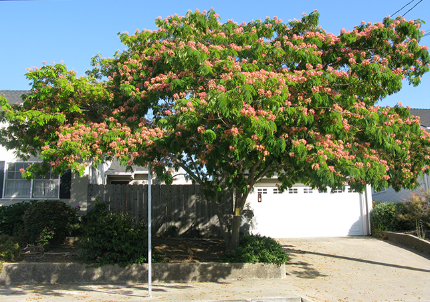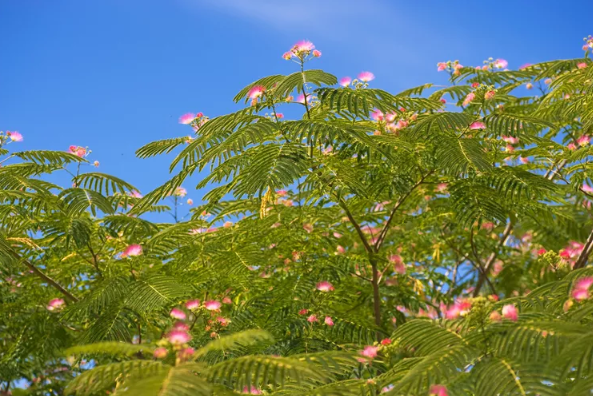
The Persian Silk Tree, scientifically known as Albizia julibrissin, is a species of tree in the Fabaceae family, native to southwestern and eastern Asia. In its native regions, the tree is often celebrated for its beauty. In Japan, it’s known as “Nemunoki” and is associated with the concept of “mono no aware,” the beauty of transience.
This tree can reach heights of 30 to 40 feet, though under optimal conditions, it might grow even taller. Its canopy can spread almost as wide as its height, giving it a broad, umbrella-like shape. This spread can be anywhere from 20 to 40 feet.
The persian silk tree has a fast growth rate, especially when young. It can add several feet in height annually under favorable conditions. It reaches maturity relatively quickly, often beginning to flower within 3-5 years from planting. However, its lifespan might be somewhat shorter than other trees, with some specimens living for 50-100 years, though this can vary widely based on conditions.
The leaves are bipinnately compound with a feathery, or fern-like appearance. Each leaf can have numerous small leaflets arranged in pairs along the leaf axis. The leaflets are typically a vibrant green, which can turn a more yellowish hue in the fall, though the tree is not particularly known for spectacular fall color changes. The leaves fold up at night, in the rain, or when touched, a phenomenon known as “sleep movements.”
The flowers are not typical in form; instead of having petals, they are made up of numerous long, slender stamens that give them a fluffy, pom-pom-like appearance. Each flower head can be about 1 to 2 inches (2.5 to 5 cm) in length. The stamens are usually pink or white, with pink. The tree typically blooms from late spring through summer, with some trees continuing to flower into early fall. The flowers are attractive to a variety of pollinators, including bees, butterflies, and even hummingbirds.
The seedpods are flat and elongated, typically measuring about 4 to 8 inches in length. Initially green, they turn brown or tan as they mature and dry out. The pods are somewhat leathery when fresh but become papery and brittle when dry. The pods ripen over the summer into early fall. They start to split open when mature, releasing the seeds.

The trunk of a mature Persian Silk Tree is straight but can become somewhat twisted or curved as it ages, especially in open environments where it doesn’t have to compete for light. While the tree can grow quite tall, the trunk diameter might not be as impressive as its height. However, older trees can develop a trunk with a diameter of 1 to 2 feet (30 to 60 cm) or more. The bark is relatively smooth when the tree is young, but as it matures, it develops a more textured, almost furrowed appearance. The texture can be described as somewhat rough or scaly, with shallow fissures.
The tree has a relatively shallow root system, which can make it prone to windthrow (being blown over by strong winds) if not properly rooted or if the soil is too loose. However, this shallow system also aids in its ability to sprout from roots or stumps, contributing to its invasiveness.
Silk tree, also called silky acacia or mimosa tree, was introduced to the United States in 1745 for use as an ornamental plant but over the time, it has naturalized and spread across many states, particularly from Virginia to Florida, and west to Texas. It’s also found in parts of the Midwest and even some northeastern states, though less commonly.
The tree is considered invasive in many areas. Its ability to grow quickly, produce abundant seeds, and sprout from roots or stumps makes it highly competitive. It can quickly colonize disturbed areas, including roadsides, abandoned fields, and forest edges. The tree can form dense stands that reduce light availability, impacting the understory and competing with native flora. This can lead to a decrease in biodiversity.
Growing Conditions
- Hardiness Zones: It grows well in USDA hardiness zones 6 through 9, though it can survive in parts of zone 5 with protection or in zone 10 with adequate moisture.
- Temperature: It prefers warm climates but can tolerate a range of temperatures. It’s frost-tolerant but may suffer damage in severe winters, especially when young.
- Sunlight: The tree does best in full sun, requiring at least 6 hours of direct sunlight daily for optimal growth and flowering. It can tolerate some shade but will have reduced vigor and fewer flowers in shadier conditions.
- Soil: It’s quite adaptable to soil types but prefers well-drained soils. It can grow in sandy, loamy, or even somewhat clayey soils, though it does best in fertile, moist conditions.
- Water: While it prefers regular moisture, especially when young, it’s somewhat drought-tolerant once established, which contributes to its ability to spread in various environments.
Environmental Adaptability
- Pollution Tolerance: It shows good tolerance to urban pollution, making it suitable for city landscapes.
- Salt Tolerance: It has moderate tolerance to salt, which can be beneficial in coastal or de-iced urban environments.